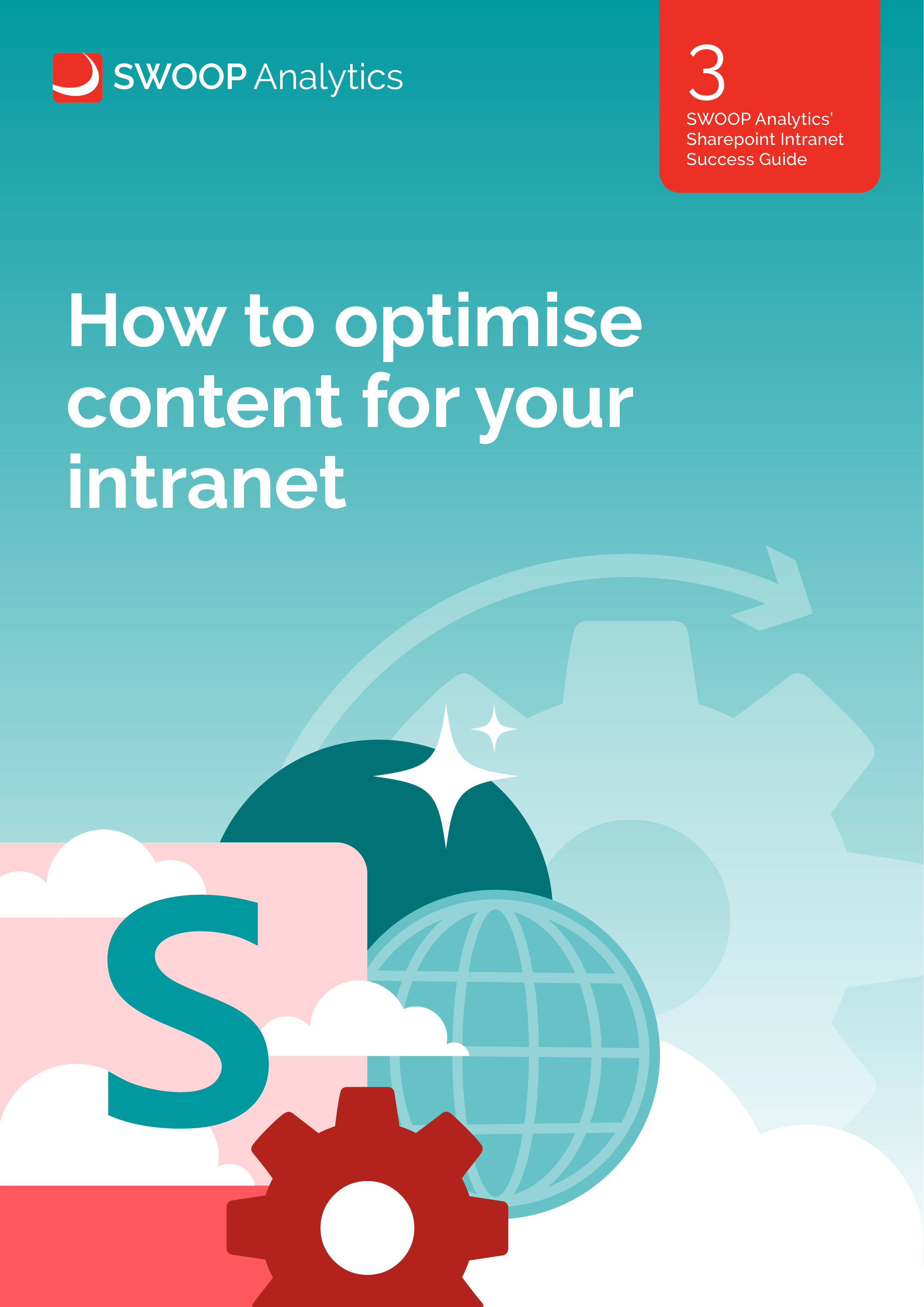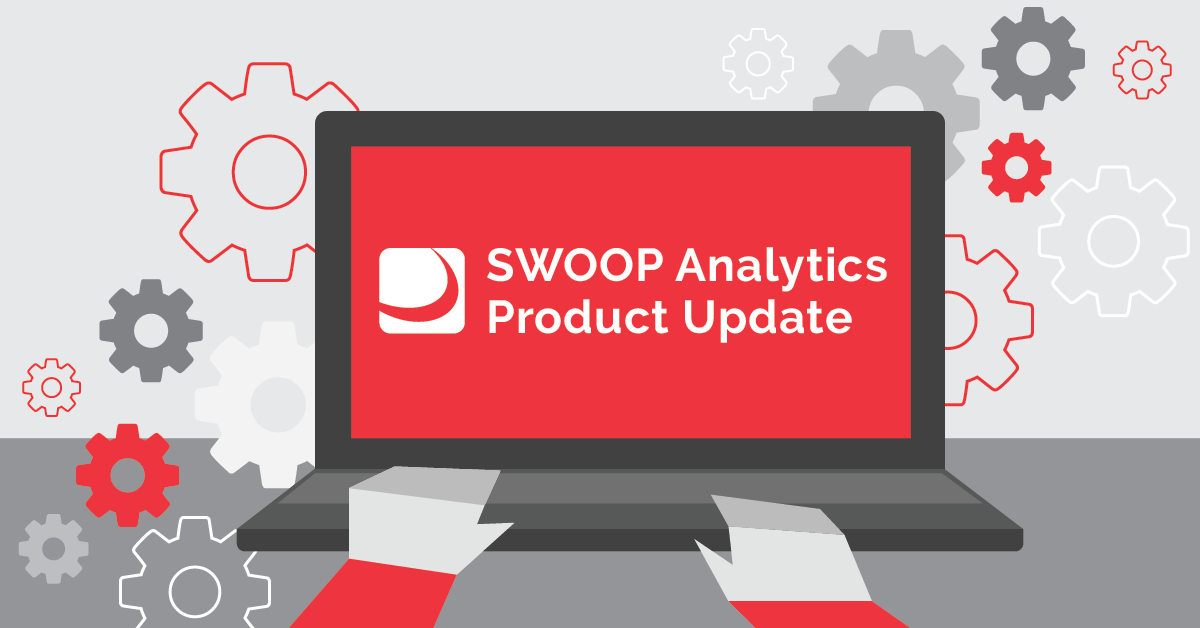
How to successfully manage an intranet
SWOOP Analytics®’ 2025 SharePoint Intranet Benchmarking Report
If you’re involved in managing, or writing for, an intranet, this is the report for you! We've analysed the real-life behaviours of 238,000 intranet visitors across 159,601 intranet pages (83,000 News pages & 77,000 Content pages) over 28 organisations to produce the world’s most comprehensive analysis of SharePoint Online intranets.
The findings from our report show exactly how people are using and accessing company intranets, and how to get your intranet AI ready. Based on this data, combined with extensive research and interviews, we’ve shaped benchmarks on what good looks like for intranet usage and answer questions anyone involved in managing, or writing for, an intranet needs to know, including:
Who uses the intranet?
• How much time employees spend visiting and reading the intranet.
• How often people visit the intranet, and how many pages they visit.
• When people are visiting the intranet.
• Do people read intranet content, or just skim it?
• How people access the intranet.
What do people want to read on the intranet?
• What types of pages are being viewed - News or Content?
• What are the most popular pages visited?
• How many News articles do people read?
• How long should an intranet News article be?
• When does intranet news become old news?
• Do Content pages get old?
Intranet governance and health
• Do home pages interfere with intranet analytics?
• How healthy are intranets and intranet pages?
Are intranets ready for AI?
• What does “AI-ready” content look like?
• What is the future of analytics for AI and intranets?
Our report is filled with tips, real-life case studies and advice from intranet experts to help you shape content to get maximum engagement.
SWOOP Analytics’ “How to successfully manage an intranet” report is FREE to download.
Join SWOOP Analytics’ 2026 SharePoint Intranet Benchmarking Study by February 1, 2026
SharePoint Intranet success guides

We've analysed the behaviours of 238,000 intranet visitors across 83,000 intranet News pages and 77,000 intranet Content pages over 28 organisations to produce our third annual SharePoint intranet benchmarking report that shows exactly how people are using and accessing organisational intranets.
Our benchmarking data will give you real-life insights into when people are reading the intranet,
what they’re reading on the intranet, how they’re accessing the intranet and
how you can best shape your content to get maximum engagement.
2025 Key Insights
More people are visiting the intranet but spending little time there
Intranet visits have risen in the past year, with 93% of all employees benchmarked accessing the intranet over the
three-month period analysed. This compares with 86% of employees accessing the intranet in 2024.
However, people don’t spend a lot of time on the intranet. On average, employees spend less than six minutes a day visiting the intranet. This means content must be quick to find, up to date and accurate.
Most people are heading to the intranet to visit Content pages. Of the 93% of employees accessing the intranet, almost 91% are accessing Content pages. News is still important though, with more than 62% also visiting News pages in the three-month period analysed.

How much time do employees spend visiting the intranet?
The average time spent on the intranet is 5.85 minutes per person each working day.
This time is down from the 16 minutes reported in 2024, however, this drop is due to a change in SWOOP Analytics’ reporting methodology so reflects more accurate tracking, not reduced interest.
People come to the intranet three times a day and look at two pages each visit
People visit the intranet three times each working day, on average, and view a little more than two pages each visit (2.19 to be precise). The average number of times employees visit the intranet each day is 3.36 - a little more than three visits per day, on average, across all employees. The most popular intranets had an average of more than 10 visits per day for each employee, while the least popular had less than one visit per day.
This is more than double the number of visits in our 2024 analysis, when the average number of visits to the intranet was 1.6 each day and the average number of pages viewed was also 1.6.

When are people visiting the intranet?
Most people visit the intranet between Monday and Friday, with the peak times at 9am and 2pm.
SWOOP Analytics’ benchmarking of SharePoint intranets found Mondays and Tuesdays are slightly more popular days, with a slight dip on Wednesdays, another increase on Thursdays, while Fridays are the quietest day of the working week. Saturday is the day the fewest number of people visit the intranet, followed by Sundays.
The peak time employees visit the intranet is at 9am on weekdays, followed by 2pm on weekdays. This could be partly attributed to the fact that some organisations have their intranet as their default web browser page and therefore when people log onto work each day, or after their lunch break, they see the intranet home page and visit an intranet site.
The third most popular time people visit the intranet is at 8am on weekday mornings, followed by 10am. Overall, intranets are well visited any time between 8am and 3pm on weekdays, with a drop off at noon and a significant drop off after 3pm.
Who is visiting the intranet?
Pretty much everyone! As part of SWOOP Analytics’ benchmarking of SharePoint intranets we looked at more than 42,000 job titles to see who is accessing the intranet. The good news is, intranet News and Content is reaching most roles, with a high diversity of job titles accessing the intranet.
The most frequent job titles are managers and team leads. At the lower end of the scale are administrative and frontline workers.

How do people access the intranet?
Via their desktop.
SWOOP Analytics’ benchmarking of SharePoint intranets found 91.6% of employees access the intranet from their desktop.
Interestingly though, there has been a significant increase in the number of people who access the intranet from their phone, up to 8.3% this year compared with just 1.45% in 2024. Only 0.1% of employees access the intranet via a tablet. These figures correlate with the lower number of frontline workers accessing the intranet.
The number of intranet News pages exceeds Content pages
Of the almost 160,000 pages analysed as part of SWOOP Analytics’ 2025 SharePoint intranet benchmarking study, 52% were intranet News pages and 48% were Content pages. For some organisations, news is the primary use of the intranet.
In our 2024 study, 60% of pages were News pages, compared with 40% Content pages.

People are visiting Content pages more often than
News pages
While there are more News pages than Content pages on most intranets, it’s the Content pages that people visit more often.
On average, 67% of Content pages are visited, while 41% of News pages are visited by employees.
How many News articles do people visit each week?
SWOOP Analytics’ benchmarking of SharePoint intranets found people visit, on average, four news articles each week.
In our 2025 study, two organisations outperformed, with people visiting more than 10 news articles each week.
We also looked at whether people spend enough time on each page to read the entire News article from start to finish. We found only about 33% of News pages are read from the start to the end. Therefore, about 67% of News articles are being scanned or skimmed rather than comprehensively read from start to finish.

How long should an intranet news article be?
The most popular length of an intranet News article is less than 200 words. Although, articles up to 400 words can still be effective.
However, no matter the length of the news article, even when it exceeds more than 1000 words, people spend, on average, almost the same amount of time on the page as if they were reading a 100-word article. We can conclude that longer articles are skimmed rather than comprehensively absorbed, so writing shorter articles could be more impactful to get important messaging across.
When does intranet news become old news?
After about two days.
Surprisingly, marginally more people read intranet news the day after it’s been published than the day it is first published. However, it’s important to note that many people still read intranet news articles for at least 10 days after the article is published, and 60% of the page visits come after more than 10 days.

Do Content pages get less popular with age?
Not really.
SWOOP Analytics’ benchmarking of SharePoint intranets found the average number of visits to Content pages in the first 10 days was about 8,000, but that number increases to more than 21,000 after 80 days from our benchmarking sample. This shows many Content pages are evergreen intranet pages, so it’s important to ensure they are always up to date with accurate content, and they are easy to navigate.
Do home pages interfere with intranet analytics?
Not really. In fact, we found on average 96.4% of people who visit the intranet home page also visited other intranet pages. Therefore, the chances of them accidentally accessing the intranet via the homepage is only 3.6%. People come to the intranet for a purpose, regardless of whether it's the default internet browser home page.

Are intranets ready for AI?
SWOOP Analytics created an AI Readiness Index based on content readiness (quality and experience design), engagement (visit times) and intranet search effectiveness. On a scale of 0–100, the average AI readiness was 51.1, with scores ranging from a minimum of 41.4 to a maximum of 64.8.
There is a long way to go before most intranets are ready for AI to support chatbots, but with the ever-increasing use of AI, health of intranet pages will become even more critical.
In SWOOP Analytics' 2025 SharePoint intranet benchmarking we analysed:
238,000 intranet visitors
159,601 intranet pages
83,000 intranet News pages
77,000 intranet Content pages
28 organisations
Each page was analysed for:
Number of visitors
Visit time
Health: Engagement
Health: Experience
Health: Quality
Page creator/editors
Date/time created/modified
Page ID
Site ID
User ID
Date / time viewed
Page length, words, paragraphs
Device used to access















